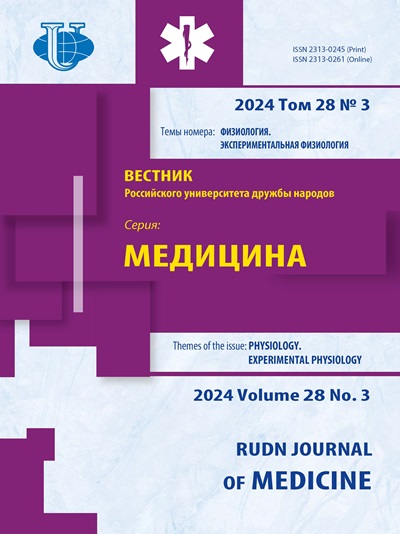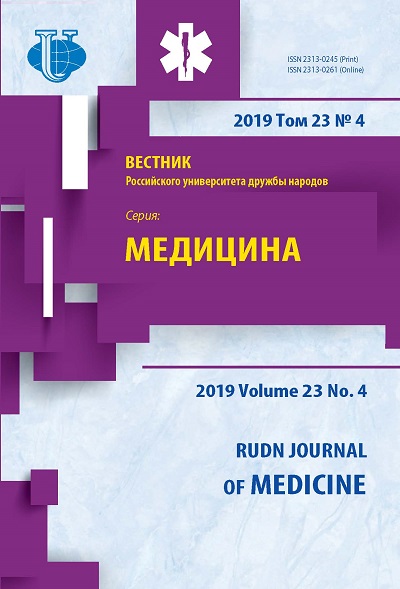Иммуногистохимическое исследование пролиферативной активности опухолевых клеток при различных градациях аденокарциномы предстательной железы
- Авторы: Кудрявцев Г.Ю.1, Кудрявцева Л.В.1, Михалева Л.М.2, Бабиченко И.И.1
-
Учреждения:
- Российский университет дружбы народов
- Научно-исследовательский институт морфологии человека
- Выпуск: Том 23, № 4 (2019)
- Страницы: 364-372
- Раздел: ОНКОЛОГИЯ
- URL: https://journals.rudn.ru/medicine/article/view/22796
- DOI: https://doi.org/10.22363/2313-0245-2019-23-4-364-372
Цитировать
Полный текст
Аннотация
Актуальность. Рак предстательной железы является одной из ведущих причин смерти мужского населения от онкологических заболеваний в развитых странах. Современные методы диагностики, в том числе пункционная биопсия предстательной железы, позволяют верифицировать онкологию на ранних стадиях, однако рутинные исследования не всегда позволяют спрогнозировать течение и исход заболевания. Цель: провести анализ клинико-морфологических и иммуногистохимических особенностей клеток аденокарциномы, с использованием маркера Ki-67, сопоставление степени пролиферативной активности в опухолях различной степени злокачественности (по классификации Глисона), а также сравнение данного показателя с клинической стадией заболевания, уровнем простатспецифического антигена в крови, объемом предстательной железы. Материалы и методы: На базе ГБУЗ ДЗМ «Городская клиническая больница № 31» и «Госпиталь для ветеранов воин № 2» были отобраны парафиновые блоки с материалом, полученным в результате биопсии предстательной железы, трансуретральной резекции и радикальной простатэктомии. Проведено морфологическое и иммуногистохимическое исследование материала с маркером Ki-67. Полученные данные проанализированы при помощи программы STATISTICA 10.0 с использованием оценки нормальности распределения данных по W-критерию Шапиро-Уилка, достоверность различий оценивалась с помощью U-критерия Манна-Уитни, а корреляционные взаимоотношения с помощью коэффициента корреляции Спирмена. Результаты: Выявлены статистически значимые отличия пролиферативной активности в группах злокачественной опухоли с разной степенью дифференцировки. Статистически значимая прямая корреляция умеренной выраженности была выявлена при сопоставлении пролиферативной активности со степенью дифференцировки по системе Глисона (rs = 0,523) и клинической стадией заболевания (rs = 0,646). Между такими показателями, как уровень простатспецифического антигена, возраст, объем предстательной железы и индексом пролиферативной активности статистически значимых корреляционных зависимостей обнаружено не было. Заключение: учет индекса пролиферативной активности в дополнение к клинико-морфологическому исследованию способствует диагностике и последующему прогнозированию течения рака предстательной железы.
Об авторах
Г. Ю. Кудрявцев
Российский университет дружбы народов
Автор, ответственный за переписку.
Email: kgosha@mail.ru
Москва, Российская Федерация
Л. В. Кудрявцева
Российский университет дружбы народов
Email: kgosha@mail.ru
Москва, Российская Федерация
Л. М. Михалева
Научно-исследовательский институт морфологии человека
Email: kgosha@mail.ru
Москва, Российская Федерация
И. И. Бабиченко
Российский университет дружбы народов
Email: kgosha@mail.ru
Москва, Российская Федерация
Список литературы
- Cooperberg M, Carroll PR. Trends in management for patients with localized prostate cancer, 1990-2013. JAMA. 2015;314(1): 80-82.
- Matoso A, Epstein JI. Grading of prostate cancer: Past, present, and future. Curr Urol Rep. 2016;17: 576-8.
- Gordetsky J, Epstein J. Grading of prostatic adenocarcinoma: current state and prognostic implications. Diagn Pathol. 2016;11: 1-8.
- Léon P, Cancel-Tassin G, Drouin S. Comparison of cell cycle progression score with two immunohistochemical markers (PTEN and Ki-67) for predicting outcome in prostate cancer after radical prostatectomy. World J Urol. 2018;36: 1495-1500.
- Bratt O, Folkvaljon Y, Hjalm Eriksson M, Akre O, Carlsson S, Drevin L. et al. Undertreatment of men in their seventies with high-risk nonmetastatic prostate cancer. Eur Urol. 2015;68(1): 53-58.
- Babichenko II, Andriukhin MI, Pulbere S, Loktev A. Immunohistochemical expression of matrix metalloproteinase-9 and inhibitor of matrix metalloproteinase-1 in prostate adenocarcinoma. Int J Clin Exp Pathol. 2014;7(12): 9090-8.
- Berlin A, Castro-Mesta JF, Rodriguez-Romo L, Hernandez-Barajas D, González-Guerrero JF, Rodríguez-Fernández IA et al. Prognostic role of Ki-67 score in localized prostate cancer: A systematic review and meta-analysis. Urol Oncol. 2017;35(8): 499-506.
- López IH, Parada D, Gallardo P, Gascón M, Besora A et al. Prognostic correlation of cell cycle progression score and Ki-67 as a predictor of aggressiveness, biochemical failure, and mortality in men with high-risk prostate cancer treated with external beam radiation therapy. Rep Pract Oncol Radiother. 2017;22(3): 251-7.
- Boladeras A, Martinez E, Ferrer F. Localized prostate cancer treated with eternal beam radiation therapy: long-term outcome at a European comprehensive cancer centre. Rep Pract Oncol Radiother. 2016;21(3): 181-7.
- Richards-Taylor S, Ewings SM, Jaynes E, Tilley C, Ellis SG, Armstrong T. et al. The assessment of Ki-67 as a prognostic marker in neuroendocrine tumors: a systematic review and meta-analysis. J Clin Pathol. 2016;69: 612-8.
- Nitz U, Gluz O, Huober J, Kreipe HH, Kates RE et al. Final analysis of the prospective WSG-AGO EC-Doc versus FEC phase III trial in intermediate risk (pN1) early breast cancer: efficacy and predictive value of Ki67 expression. Ann Oncol. 2014;25: 1551-7.
- Cserni G, Voros A, Liepniece-Karele I, Bianchi S, Vezzosi V. et al. Distribution pattern of the Ki67 labelling index in breast cancer and its implications for choosing cut-off values. Breast. 2014;23: 259-63.
- Amin MB, Edge SB, Greene FL. AJCC Cancer Staging Manual. 8th ed. New York: Springer International Publishing; 2017. 451 p.
- Epstein JI, Egevad L, Amin MB et al. The 2014 International Society of Urological Pathology (ISUP) Consensus Conference of Gleason Grading of Prostatic Carcinoma. Am. J. Surg. Pathol. 2016, 40: 244-52.
- Gevorkyan AR, Avakyan AYu, Efremov EA, Simakov VV. Correlation between Gleason score and PSA level. Experimental and Clinical Urology. 2014;3: 37-9.
- Kammerer-Jacquet SF, Ahmad A, Møller H, Sandu H, Scardino P, Soosay G et al. Ki-67 is an independent predictor of prostate cancer death in routine needle biopsy samples: proving utility for routine assessments. Mod Pathol. 2019;32: 1303-9. doi: 10.1038/s41379-019-0268-y
- Lobo J, Rodrigues Â, Antunes L, Graça I, Ramalho-Carvalho J, Vieira FQ et al. High immunoexpression of Ki67, EZH2, and SMYD3 in diagnostic prostate biopsies independently predicts outcome in patients with prostate cancer. Urol Oncol. 2018;36(4): 161.e7-161.e17. doi.org/10.1016/j.urolonc.2017.10.028
















